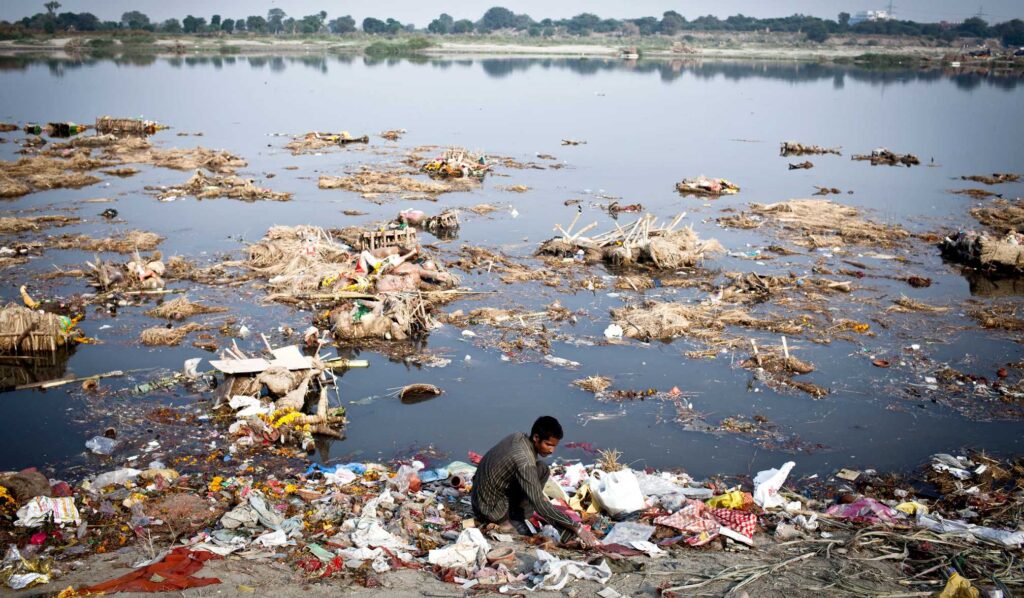Growing up, I often used to receive projects about types of pollution and like many kids, flip through charts and newspapers to find relevant images. I remember looking at rivers with foam and air filled with smoke, thinking it to be some distant land or at least something that couldn’t possibly happen around me. Fast forward to today, I sit in the capital city, watching those images turn into a tragic reality, realizing it isn’t a temporary crisis.
Recently, a viral video has been a topic of conversation among netizens due to the bizarre act of a woman who was spotted washing her hair in the holy waters of the Yamuna River in the capital city. The bizarre part is- that she was washing her hair with toxic foam assuming it to be a shampoo. As a part of the Chaath Puja rituals, she was taking a dip, accompanied by several other devotees in Yamuna, and started taking the foam to rub it on her head, as if it was a naturally occurring shampoo. Here take a look:
The video is both revolting and thought-provoking. It isn’t just one mere incident this year, but an annual occurrence. Every winter, we are reminded of the despairing faith our rivers have to go through, along with the poor air quality. While the internet is reacting to the video, in very few days (or even hours) will forget about the same. Sadly, we have grown accustomed to these environmental catastrophes that no longer push us to think – why is this happening?
There are several layers of reasons that answer the question. Starting right from the government’s lack of accountability, and systematic failure to our complete negligence and collective disregard for duties of being the citizens and inhabitants of our planet.
Yamuna is a river on its deathbed. Light foam and froth in rivers are a naturally occurring phenomenon, but it has turned into a deadly event in Yamuna. The river witnesses the release of detergents containing phosphates and surfactants, industrial and residential waste, and untreated sewage. According to India Today, the river receives over 3.5 billion liters of sewage each day, yet only 35 to 40 percent undergo treatment. A river considered to be among the holiest in our culture, is just an inch away from being converted into a drain, yet, we have not paid any heed to it. For years.

In 2023, the Delhi Government pledged to clean the river by 2025. Sadly, the campaign deadline has been conveniently pushed to 2026. A report by The Indian Express reveals that the central government has granted the Yamuna Cleaning mission over Rs. 8,500 crore along with major other donations. Clearly, our authorities have all the money in the world to save our rivers, but not the will. The presence of toxic foam is a visible testament to decades of mismanagement and systematic failure. Everything is done – promises are made, action plans are designed, schemes are launched, studies are presented and leaders campaign for it every time near the elections – but the foam and pollutants are still there, thick and toxic as ever.
What is equally alarming is how the public has come to accept it. We normally carry on with our lives, convincing ourselves that this is an unavoidable reality. Sadly, we have also stopped seeking accountability from our elected leaders, industries, and each other. We equally share the blame as passive witnesses and even as participants through our consumption and disposal patterns. Consciously or unconsciously, we have polluted our environment through our small steps.
We don’t know what the woman assumed while washing her hair. She might thought it to be shampoo or simple harmless foam, but it points towards a larger truth. This larger and uncomfortable truth is our apathy that has crept into our mind, that it is okay to ignore issues like this if it is not bothering us on a daily basis. It is high time we realize that Yamuna is not just the government’s or any NGO’s responsibility – it is a part of our environment, and we as citizens are liable for our actions and choices.




















